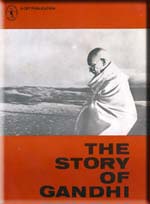
P.O. SEVAGRAM, DIST.WARDHA 442102, MS, INDIA. Phone: 91-7152-284753
FOUNDED BY MAHATMA GANDHI IN 1936
The Story of Gandhi

THE STORY OF GANDHI
Written by : Rajkumari Shanker
Table of Contents
- Birth And Childhood
- Preparation for England
- In England
- Back In India
- In South Africa
- In India
- Back In South Africa
- Indian National Congress
- In South Africa Again
- Assault
- Tolstoy Farm
- Returned To India
- Establishment of Satyagraha Ashram
- Benaras Speech
- Champaran Satyagraha
- Ahmedabad Mill-Workers Satyagraha
- Rowlatt Act
- Jallianwalla Bagh Massacre
- In Prison
- Salt Satyagraha
- Sevagram
- Cabinet Mission Plan
- Quit India
- He Ram!!!
About This Book
Written by : Rajkumari Shanker
First Edition :1969
I.S.B.N :81-7011-064-5
Published by :Children's Book Trust,
Nehru House, 4
Bahadur Shah Zafar Marg,
New Delhi 110 002,
India.
© CBT, 1969
Download
Chapter-11: Tolstoy Farm

Hermann Kallenbach, a white farmer, was so impressed with the peaceful way of life at Phoenix that he offered Gandhi his own big farm near Johannesburg to start another colony. He suggested that all those who had lost their jobs and homes by their participation in the Satyagraha could be settled there.
The new colony was established in 1910 and named ‘Tolstoy Farm’, after the great Russian writer whom Gandhi much admired. Here people who were different in nationality, religion, and colour lived together like one family. They worked hard and shared the fruits of their labour.
Gandhi spent much of his time at Tolstoy Farm. He was engaged in teaching the children and in other constructive activities.
Gandhi’s efforts to persuade General Smuts to change the attitude of the Government towards the Indians had failed. Meanwhile, the struggle continued against the ‘Black Act’
and the poll-tax. And now hundreds of Indian women, including kasturbai, joined the movement.
There had been a recent court decision in South Africa holding that Indian marriages were not recognized by law. The women could not brook this attack on family ties.
They openly broke the law and were imprisoned in large numbers. In the coal mines at Newcastle, in Natal, Indian workers went on strike protesting against the repression.
The arrests, the deportation of passive-resisters, and the untold sufferings of Indian families angered the people of India. A large amount of money was collected for the relief of the victims.
Many satyagrahis were beaten and flogged and some were even killed. Gandhi, who felt intensely the humiliation his people suffered, took a triple vow of self suffering. He decided to dress like a poor laborer, to walk bare-foot, and have only one meal a day, till the poll-tax and other injustices were abolished.
Gandhi found the Government relentless. There was no solution in sight. He had to take further measures.
In October 1913 Gandhi organized a march of over 6,000 Indian workers from the Natal mining area into the Transval, although crossing into the Transvaal without a permit was not allowed by law.
Gandhi said, ‘We are going to march peacefully together across the border into the Transvaal. The Government will arrest us and put us in prison. We are to remain peaceful. This is the non-violent way of protesting against the poll-tax, against government’s decision not to recognize our marriages, and against all the laws that are made against us. We are fighting for just causes, we will not harm anyone.’
He then cried to the people, ‘Are you ready to face arrest and harsh treatment, remaining always non-violent?’
Roars of assent assured him to everyone’s support. They were ready to follow Gandhi anywhere. And so the march into the Transvaal began.
Late in the evening Gandhi was roused from sleep by several uniformed men.
‘I know,’ he said,’ you have come to arrest me. I am ready.’ Gandhi and many other Indians were imprisoned. The mines were surrounding with barbed wire and converted into temporary jails. The satyagrahis were beaten and flogged to force them to go back to work, but without success. The authorities could not make them return to work. Gandhi had aroused in them the spirit of quiet, dignified resistance.
Soon the movement of passive resistance, or Satyagraha, spread all through Natal and the Transvaal. The Government did not know what to do, because none yielded to their cruel treatment. The prisons were overflowing. At last General Smuts was obliged to act. He appointed a Commission to study the situation.
In December 1913 Gandhi was released, but he would not give up the struggle.
Gandhi threatened Smuts that he would start another march if his demands were not met. That march, however, never took place.
The European employees of the railways in the Union went on strike, and this made the Government’s position extremely difficult. Gandhi decided to drop the idea of the march at such a critical time as he did not wish to embarrass the Government further.
Gandhi ordered every Indian to go back to work, at least for the time being. His decision created a good impression on the Government and even General Smuts recognized this courtesy.
The Inquiry Commission reported in favour of all the essential reforms demanded by the Indian leaders.
The Indians’ Relief Bill was at last passed and signed by the Governor. It abolished legal all Indian marriages, and removed penalties for crossing from one state to another.
Gandhi had won. And so had the Satyagraha movement.
Gandhi had been active in South Africa for twenty-one years and had contributed much to the welfare of the Indians in South Africa.